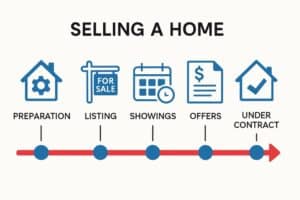Key Takeaways
- Prepare Your Home: Repairs, staging, and professional photos attract buyers faster.
- Target the Best Buyers: Focus marketing on the audience most likely to purchase.
- Stay Flexible: Prompt showings and open houses speed up offers.
- Be Responsive: Quick negotiation and organization keep the process on track.
- Plan for Closing: Inspections, appraisals, and paperwork require careful coordination.
Introduction
Selling a home is a complex process, and understanding the typical timeline ensures a smoother, less stressful experience. Whether you’re relocating, downsizing, or moving for work, setting realistic expectations is key. From preparing your property for listing to handing over the keys on closing day, each step comes with its own timeframe and requirements. If you’re seeking convenience or speed, getting a cash offer can simplify the process and reduce overall time on the market.
Traditional sales often involve multiple stages, each with unique challenges and opportunities for delay. By familiarizing yourself with what to expect, you’ll be better equipped to avoid common pitfalls and maximize the value of your home. This guide walks you through each phase, helping you prepare for the journey ahead and make informed decisions along the way.
Alongside traditional listings, it’s important to consider all selling options for your unique situation.

Preparing Your Home for Sale
Getting your home market-ready is the foundation of a successful sale. This preparation involves several key steps:
- Repairs and Upgrades: Address deferred maintenance issues and consider minor upgrades, such as fresh paint, new fixtures, or landscaping improvements, to make the property attractive to buyers.
- Decluttering and Staging: Remove excess personal belongings and stage the home to highlight its best features, making it easier for buyers to imagine themselves living there.
- Professional Photography: High-quality images are essential for online listings and marketing, as most buyers begin their search via the internet.
This initial phase typically takes anywhere from one to four weeks, depending on your schedule and the home’s condition. Proactive preparation not only boosts your home’s appeal but can also reduce the time it spends on the market, as outlined by Zillow’s home selling guide.
Listing and Marketing
Once your home is ready, it’s time to list and actively market the property. This key phase involves hiring a qualified real estate agent who knows the local market, assisting with pricing, paperwork, marketing, and negotiations—a process that can take five to seven days. With your home prepared, your agent will list it on the MLS and online platforms while developing a marketing plan that may include open houses, digital advertising, and print materials. Targeting the best buyers—those most likely to be interested in your property based on location, lifestyle preferences, and budget—helps ensure your marketing reaches the right audience and can lead to quicker offers.
Showings and Open Houses
Following the listing, your agent will coordinate private showings and schedule open houses:
- Scheduling Showings: Buyer interest often peaks within the first few days after the home hits the market, so prompt viewing access is important.
- Hosting Open Houses: Open houses, typically held within the first week, can draw multiple buyers at once and help generate offers quickly.
Depending on the real estate climate in your region, the showing phase can last one to four weeks. Strong market demand often leads to quicker results. As noted by Realtor.com, strategic timing and flexibility can minimize days on market.
Receiving and Negotiating Offers
Once buyers begin to express interest, you’ll start receiving offers:
- Receiving Offers: In competitive markets, you may receive multiple offers within days. In slower seasons or buyer’s markets, it could take several weeks.
- Negotiations: Expect negotiations over price, contingencies, and closing dates. Counteroffers may be exchanged, often adding a few days to a week to this phase.
Typically, this stage lasts from two days to a month. Remaining responsive and willing to negotiate ensures momentum isn’t lost during tactical back-and-forth discussions.
Under Contract and Due Diligence
With an accepted offer, the sale transitions to due diligence and contract finalization:
- Home Inspection: Usually completed within 7 to 10 days after signing the contract. The results may prompt negotiations for repairs or concessions.
- Appraisal: Required when buyers utilize financing, the appraisal can take several days to a few weeks and is ordered by the buyer’s lender.
- Buyer’s Mortgage Approval: The underwriting process can be the most time-consuming, taking 30 to 45 days as lenders verify finances, employment, and the property’s value.
This entire phase often spans 30 to 60 days. Delays can occur if issues are discovered during inspection or if the buyer’s financing falls through, as noted in Bankrate’s home selling timeline.
Closing
The final milestone in selling your home is closing:
- Final Walkthrough: Usually scheduled a day or two before the closing date, allowing the buyer to ensure the home is in agreed-upon condition.
- Signing Documents: Both seller and buyer sign a variety of legal documents, transferring title and processing the transaction. Once paperwork is finalized and funds are distributed, ownership officially changes hands.
Closing typically occurs 30 to 60 days after accepting an offer, assuming there are no title, appraisal, or financing complications.
Final Thoughts
The entire home selling timeline generally ranges from two to four months, shaped by local market conditions, the home’s readiness, and your chosen selling strategy. Staying organized, addressing each phase proactively, and considering alternative solutions can make the difference between a stressful process and a successful, efficient transaction.






